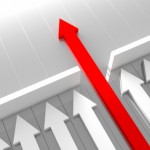 The WSJ reports in “Mutual Funds Race to Join ETF Fray” (subscription required) that mutual fund companies are accelerating their efforts to join the spreading ETF movement:
The WSJ reports in “Mutual Funds Race to Join ETF Fray” (subscription required) that mutual fund companies are accelerating their efforts to join the spreading ETF movement:
After watching the exchange traded fund industry streak past $1 trillion of assets recently, a host of mutual-fund companies are stepping up their efforts to get into the game—with a more active but pricier product for investors.
Fund giants from Eaton Vance to Blackrock iShares have gotten regulators’ approval to roll out what the industry calls more actively managed ETFs. Janus, AllianceBernstein and Dreyfus have sought permission. Last month, Pimco said it would launch an ETF version of its $240 billion Total Return fund.
They are seeking to join the still-small group of actively-managed ETFs: funds that trade all day long on an exchange like stocks, but with underlying investments that are chosen, and traded, by a pro. Companies tout their market-beating potential—and charge more for the promise of added returns.
Fans say the new breed of ETFS will give investors a chance to juice returns at a still relatively low price.
“It provides much broader and in many cases easier access to a firm like Pimco,” says Don Suskind, head of the ETF product-management team at the southern-California bond shop, which already runs one of the largest actively managed bond ETFs, the $920 million Enhanced Short Maturity Strategy ETF and plans to launch another one.
ETFs are popular in part because of their low costs. Critics say the new offerings will lead to higher—not lower—fees for investors. Among the handful of active ETFs already on the market, fees run from 0.35% to 1.85% of assets a year. At the high end, that is almost double the average actively managed large-cap stock mutual fund, and considerably higher than index ETFs, which range from 0.1% to 1%.
Such differences don’t matter much for short-term traders. For long-term investors, a cheaper fund could generate thousands of dollars more in profit—everything else being equal.
Fund companies say all else isn’t equal, and that active ETFs will beat the market and earn their higher expense ratios and then some.
I don’t think the emphasis should be whether active or passive ETFs are better, because both will have their day in the sun depending on market conditions.
From my viewpoint, the far more important issue is what investment approach you are using with these ETFs. Sure, if you are in the buy-and-hold camp, then annual expenses will be far more important to you than if you are employing my trend tracking methodology.
Why? For one, you will be “stuck” with these ETFs for many years to come as you simply sit and wait it out no matter what the market does. It you are in trend tracking mode, you will select ETFs based on their performance and momentum figures, and buy them as soon as they cross their long-term trend line to the upside, as I elaborate on in my weekly ETF Cutline reports.
Once you have established a position, you should monitor it on a daily basis by setting up your trailing sell stop points. As a result of this approach, you may get onboard a great performing ETF early in the cycle and exit when market momentum wanes and your sell stops get triggered.
Going this route makes it less important to focus on annual expenses. After all, if an ETF can provide you with a superior performance, do you really care what the expenses are or whether it is an active or passive ETF?
I have seen too many investors make the annual expense ratio a determining factor in ETF selections, when this should only be a secondary consideration. If you do, you may very well end up saving pennies and wasting dollars.
Contact Ulli